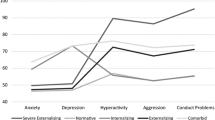Abstract
Limited information exists regarding how some popular measures for assessing the effectiveness of services to children with severe emotional disturbance interrelate when used as part of ongoing outcome accountability systems. This article examines the interrelationships—at intake and over time—between the Child Behavior Checklist (CBCL), the Youth SelfReport (YSR), the Child and Adolescent Functional Assessment Scale (CAFAS), andDiagnostic and Statistical Manual of Mental Disorders, Fourth Edition (DSM-IV) clinical diagnoses across six California care systems. At intake, there were mild to moderate relationships between the clinical diagnosis, the CAFAS, the CBCL, and the YSR. These relationships were not as strong as those found in other studies conducted in more controlled research environments. There was limited agreement among the CAFAS, the CBCL, and the YSR regarding the outcomes of the youths served. These findings raise questions regarding translating measures from research settings to clinical environments and reconciling differences between outcome measures.
Similar content being viewed by others
References
Hernandez M, Hodges S, Cascardi M. The ecology of outcomes: system accountability in children's mental health.Journal of Behavioral Health Services & Research. 1998;25(2):136–150.
Hoagwood K, Jensen PS, Petti T, et al. Outcomes of mental health care for children and adolescents: I. A comprehensive conceptual model.Journal of the American Academy of Child and Adolescent Psychiatry. 1996;35:1055–1063.
Rosenblatt A. Assessing the child and family outcomes of systems of care for youth with severe emotional disturbance. In: Epstein MH, Kutash K, Duchnowski A, eds.Outcomes for Children and Youth with Emotional and Behavioral Disorders and Their Families: Programs and Evaluation Best Practices. Austin, TX: PRO-ED Publishers; 1998:329–362.
Vitiello B, Malone R, Buschle PR, et al. Reliability of DSM-III diagnoses of hospitalized children.Hospital and Community Psychiatry. 1990;41:63–67.
Achenbach TM.Manual for the Child Behavior Checklist/4-18 and 1991 Profile. Burlington, VT: University of Vermont Department of Psychiatry; 1991.
Achenbach TM.Manual for the Youth Self Report and 1991 Profile. Burlington, VT: University of Vermont Department of Psychiatry; 1991.
Hodges K.The Child and Adolescent Functional Assessment Scale. Ypsilanti, MI: Eastern Michigan University Psychology Department; 1994.
Public Health Services Act, 42 USC 290ff et seq.
Achenbach TM, McConaughy SH, Howell CT. Child/adolescent behavioral and emotional problems: implications of cross-informant correlations for situational specificity.Psychological Bulletin. 1987;101:213–232.
Achenbach TM.Integrative Guide for the 1991 CBCL/4-18, YSR, & TRF Profiles. Burlington, VT: University of Vermont, Department of Psychiatry, 1991.
Shaffer D, Fisher P, Dulcan MK, et al. The NIMH Diagnostic Interview Schedule for Children version 2.3 (DISC-2.3): description, acceptability, prevalence rates, and performance in the MECA Study.Journal of the American Academy of Child and Adolescent Psychiatry. 1996;35:865.
Bird HR, Gould MS, Staghezza B. Aggregating data from multiple informants in child psychiatry epidemiological research.Journal of the American Academy of Child and Adolescent Psychiatry. 1992;31:78.
Edelbrock C, Costello AJ. Convergence between statistically derived behavior problem syndromes and child psychiatric diagnoses.Journal of Abnormal Child Psychology. 1988;16:219–231.
Gould MS, Bird H, Staghezza Jaramillo B. Correspondence between statistically derived behavior problem syndromes and child psychiatric diagnoses in a community sample.Journal of Abnormal Child Psychology. 1993;21:287–313.
Jensen PS, Salzberg AD, Richters JE, et al. Scales, diagnoses, and child psychopathology: I. CBCL and DISC relationships.Journal of the American Academy of Child and Adolescent Psychiatry. 1993;32:397–406.
Jensen PS, Watanabe HK, Richters JE, et al. Scales, diagnoses, and child psychopathology: II. Comparing the CBCL and the DISC against external validators.Journal of Abnormal Child Psychology. 1996;24:151–168.
Kazdin AE, Heidish IE. Convergence of clinically derived diagnoses and parent checklists among inpatient children.Journal of Abnormal Child Psychology. 1984;12:421–435.
Weinstein SR, Noam GG, Grimes K, et al. Convergence of DSM-III diagnoses and self-reported symptoms in child and adolescent inpatients.Journal of the American Academy of Child and Adolescent Psychiatry. 1990;29:627–634.
Hodges K, Wong MM. Psychometric characteristics of a multidimensional measure to assess impairment: the Child and Adolescent Functional Assessment Scale.Journal of Child Family Studies. 1996;5:445–467.
National Advisory Mental Health Council.Bridging Science and Service. A report by the National Advisory Mental Health Council's Clinical Treatment and Services Research Workgroup. Bethesda, MD: National Institute of Mental Health; 1999.
Jordan DD, Hernandez M. The Ventura planning model: a proposal for mental health reform.The Journal of Mental Health Administration. 1990;17:26–47.
Hernandez M, Goldman SK. A local approach to system development: Ventura County, California. In: Stroul BA, ed.Children's Mental Health: Creating Systems of Care in a Changing Society. Baltimore, MD: Paul H. Brookes; 1996:117–196.
Rosenblatt A, Wyman N, Kingdon D, et al. Managing what you measure: creating outcome driven systems of care for youth with severe emotional disturbance.Journal of Behavioral Health Services & Research. 1998;25:177–203.
American Psychiatric Association.Diagnostic and Statistical Manual of Mental Disorders. 4th ed. Washington, DC: Author; 1994.
Rosenblatt A, Rosenblatt JA. Demographic, clinical, and functional characteristics of youth enrolled in six California systems of care.Journal of Child and Family Studies. 2000;9:51–66.
Achenbach TM. The Child Behavior Checklist and related instruments. In: Maruish M, ed.The Use of Psychological Testing for Treatment Planning and Outcomes Assessment. 2nd ed. Mahwah, NJ: Lawrence Erlbaum Associates; 1999:429–466.
Hodges K. Child and Adolescent Functional Assessment Scale (CAFAS). In: Maruish M, ed.The Use of Psychological Testing for Treatment Planning and Outcomes Assessment. 2nd ed. Mahwah, NJ: Lawrence Erlbaum Associates; 1999:631–664.
Jacobson NS, Roberts LJ, Berns SB, et al. Methods for defining and determining the clinical significance of treatment effects: description, application, and alternatives.Journal of Consulting and Clinical Psychology. 1999;67(3):300–307.
Ogles BM, Melendez G, Davis DC, et al, eds.The Ohio Youth Problem, Functioning, and Satisfaction Scales [technical manual]. Athens, OH: Ohio University; 2000.
Author information
Authors and Affiliations
Corresponding author
Rights and permissions
About this article
Cite this article
Rosenblatt, A., Rosenblatt, J.A. Assessing the effectiveness of care for youth with severe emotional disturbances: Is there agreement between popular outcome measures?. The Journal of Behavioral Health Services & Research 29, 259–273 (2002). https://doi.org/10.1007/BF02287367
Issue Date:
DOI: https://doi.org/10.1007/BF02287367



